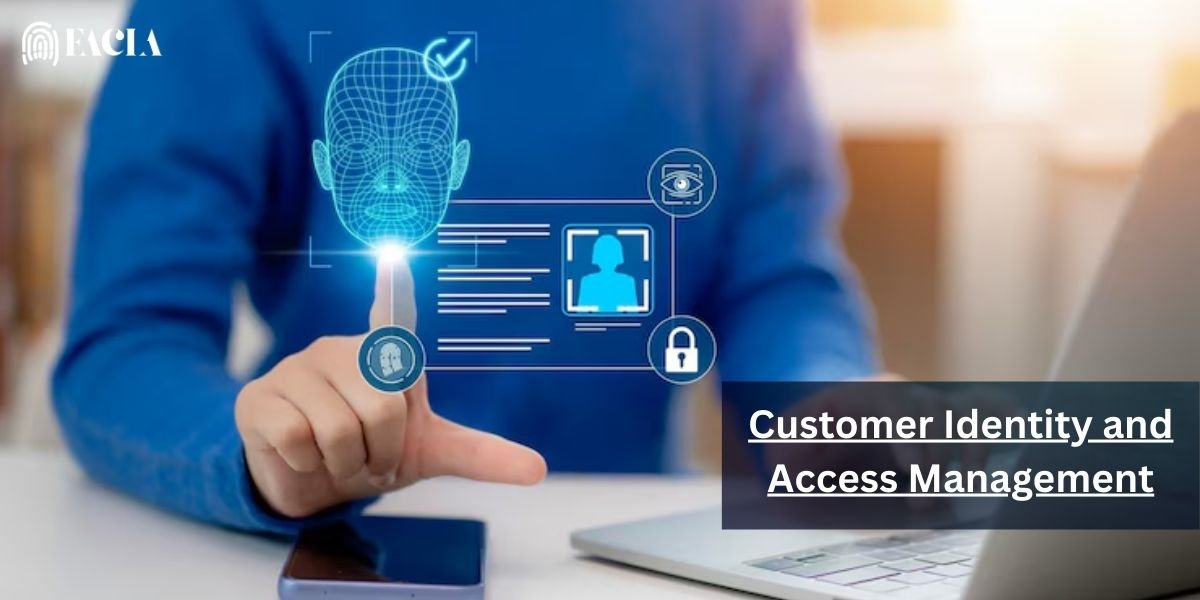In online business, everyone seeks to gain an advantage over others by implementing diverse strategies to earn customers’ trust. Delivering outstanding service is crucial for staying ahead, but ensuring seamless access to those services while keeping customer data secure is equally important.
According to the Online Authentication Barometer Report, published by the FIDO Alliance in 2023, around 60% of users abandoned access to online services because they forgot their passwords.
Customer Identity and Access Management (CIAM) solutions offer security and convenience by managing customers’ identities and privacy.
Continue reading this article to understand what is CIAM, its key features, benefits, use cases, and how it works to protect customer data.
What is CIAM? (Customer Identity and Access Management)
Customer Identity and Access Management (CIAM) is a combination of technologies and processes that ensure the authentic external user gets access easily to the online application or website. CIAM uses advanced security techniques, including multifactor authentication (MFA), to ensure that authorized users can get access. Unlike traditional Identity and Access Management (IAM), which is designed for employees only, CIAM focuses on balancing security with seamless user experiences.
A CIAM system ensures that users can easily sign up, log in, and access the application and its services while protecting their privacy. To do that, CIAM uses its multiple features to prevent fraudsters while maintaining the user experience. The system also allows users to manage their profiles, security settings, and privacy preferences.
CIAM solutions are commonly delivered as cloud-based services to ensure scalability, flexibility, and compliance with data protection regulations like GDPR and CCPA. CIAM helps organizations in enhancing their customers’ trust, reducing friction in digital interactions, and safeguarding accounts.
Further Reading:
| How to Check If a Company is Legally Registered in the USA? | What is a Shelf Company? The Ultimate Guide for Entrepreneurs |
| How To Spot Fake IDs: ID Fraud Prevention and Ways to Detect Fake IDs | What is Liveness Detection and How it Counters Digital Fraud in 2025 |
Why is CIAM Important?
Customer Identity and Access Management (CIAM) is crucial for online organizations to balance their security with user convenience. It can build customer trust by ensuring seamless access to online services while protecting their data from fraud and breaches.
A well-implemented CIAM solution enhances user experience through a simplified registration process that reduces friction and increases customer retention. At the same time, it strengthens the customer’s security with multi-factor authentication (MFA) and ensures compliance with regulations like GDPR and CCPA.
CIAM also unifies authentication and access management across multiple systems, eliminates security gaps, and improves operational efficiencies. CIAM helps businesses build customer trust and safeguard their digital interactions, providing a secure, personalized, and hassle-free user experience.
What are the Features of CIAM?
Multi-Factor Authentication (MFA)
CIAM utilizes MFA to add an extra layer of security by requiring the customer to pass through multiple verifications to access their accounts. This security feature asks for OTP or biometric verification with a password to verify the authentic user. This significantly prevents unauthorized access due to stolen passwords, ensuring that only the correct person can access sensitive information.
Single Sign-On (SSO)
Single Sign-On (SSO) simplifies the application access process for customers by allowing them to log in once and gain access to multiple applications or services. The user doesn’t need to provide credentials repeatedly or remember different passwords for each application. It supports various identity protocols such as OAuth, SAML, and OpenID Connect, and allows users to authenticate using social logins like Google, Facebook, or Microsoft accounts. This not only enhances convenience but also improves user retention and satisfaction.
Self-Service Registration and Account Management
CIAM platforms allow users to change or edit their account details once they have successfully signed up or logged in to the application. This ensures customers have full control to update or reset their passwords and adjust privacy settings without requiring any assistance. This enhances the user experience as well as frees up valuable resources for businesses by reducing the workload on support teams.
Consent and Preference Management
One of the standout features of CIAM is its ability to manage user consent and preferences. Customers can specify which data they want to share and how they prefer to be contacted. This ensures that businesses comply with data protection laws like GDPR and CCPA. These regulations require clear customer consent for collecting or using their data.
Centralized Customer Identity Management
With CIAM, managing customer profiles across multiple applications and services is easier by centralizing their user identity data. This simplifies the access control and authentication processes, ensuring that user data remains accurate and up-to-date. By managing identity in one place, businesses can securely store user data and make it easily accessible across different systems.
Identity Orchestration and Integration
CIAM connects with third-party services, identity providers, and external apps to create a flexible system that ensures authentication and authorization processes work smoothly across different systems and applications. This enables businesses to adapt to new technologies and integrate new services without compromising security, while maintaining a seamless user experience.
Scalability and Performance
The scalability feature of CIAM enables applications to handle a large number of users without performance issues or system failures. Whether a company manages thousands or millions of users, CIAM solutions ensure reliable and uninterrupted access to applications and services.
How Does CIAM Protect Customer Data?
CIAM protects customer data by combining strict access rules with privacy settings that are set by the user. While giving consumers control over data and authentication, CIAM protects sensitive data.
Users may easily register via social networking, Google, or by connecting specific devices. This simplifies signup and login with no compromise on security. When it comes to authentication, CIAM offers more than just passwords. It also offers biometric verification, passwordless login, and Single Sign-On (SSO). Users may access apps and services safely and smoothly across devices.
Customers can update passwords, account data, and security settings using self-service. All these CIAM capabilities empower consumers to protect their data and allow enterprises to require periodic credential updates for enhanced security.
Additionally, CIAM lets users maintain consistent profile information across numerous apps for tailored experiences. A centralised data management platform provides privacy and lowers data exposure. CIAM combines security and usability, enabling organizations protect consumer data.
What Are The Key Benefits Of CIAM?
Using Customer Identity and Access Management (CIAM) solutions can provide the following key benefits to the organization:
- Stronger Security Measures: CIAM protects customer data with Multi-Factor Authentication (MFA), adaptive authentication, and encryption. It adds an extra layer of security and prevents data breaches and unauthorized access.
- Seamless User Experience: With streamlined features like Single Sign-On (SSO) and account self-service, customers can manage their credentials and access multiple services without repeated logins.
- Customer Trust and Retention: Businesses can gain their customers’ trust and confidence by providing a secure and hassle-free user experience, leading to higher retention rates.
- Scalability and Performance: CIAM ensures system performance and availability while handling large volumes of user authentication.
- Compliance and Privacy Control: GDPR and CCPA laws ensure the protection of customer privacy. CIAM allows customers to control their data and helps businesses comply with these regulations.
- Customer Behavior Insights: Businesses can track user interactions, optimize services, and personalize experiences based on customer activity.
- Flexible Integration and Customization: CIAM solutions support APIs and third-party integrations, allowing businesses to adapt new technologies and make advancements in authentication processes.
How CIAM Solutions Differ from IAM Solutions?
Keeping in mind the specific needs of customers, CIAM is designed differently from IAM. While IAM only ensures that employees can securely access internal systems, CIAM, on the other hand, provides both security and convenience. IAM often does not prioritize ease of use. CIAM and IAM serve different purposes based on their users’ needs, but they may still have some similar features.
| Aspect | IAM (Identity & Access Management) | CIAM (Customer Identity& Access Management) |
| User Volume | Designed for employees, typically to handle 150,000 users | Organizations with millions of customers can use CIAM to handle this huge scale |
| User Experience | Employees must abide by the IAM policies set by their organization | Customers demand a smooth and flexible experience from the organization to log in or register on their application |
| Security Implementation | Companies can enforce MFA, device management, and strict access policies | The customer can enable or disable MFA by themselves. |
| Onboarding vs Registration | Involves HR-driven onboarding, background checks, and access approvals | Quick, user-friendly registration, often using social logins or passwordless methods |
| Account Recovery | IT support will assist the employee with recovery, following structured procedures | Needs to be instant and self-service enabled to keep the customer satisfied |
| Governance & Compliance | Strict role-based access and audit trails for regulatory compliance | Flexible access with user-driven preferences and personalized experiences |
| Support Mechanism | Helpdesk and IT-managed ticketing systems | Easy Self-service support, chatbot assistance, and automated recovery processes |
| Privacy & Data Protection | Compliance with internal security frameworks | Must comply with GDPR, CCPA, and other global data privacy laws to ensure user consent management |
CIAM use cases
Travel and Hospitality: Airlines and hotel chains implement CIAM to facilitate customers’ ability to book services, manage reservations, and improve customer satisfaction and loyalty.
E-commerce Platforms: CIAM enables customers to create and manage accounts quickly and securely. Additionally, they can track orders and receive personalized recommendations from a system that enhances the shopping experience.
Financial Services: Banks and financial institutions utilize CIAM to provide more secure online banking. Using multi-factor authentication and fraud detection mechanisms helps banks to protect their customers’ sensitive information.
Healthcare Portals: In hospitals, CIAM allows patients to access their medical records, schedule appointments, and communicate with healthcare providers securely and quickly. It also ensures that the healthcare service provider complies with health data protection regulations.
Media and Entertainment Services: Streaming platforms use CIAM to manage subscriber access, preferences, and viewing histories, delivering a personalized entertainment experience.





